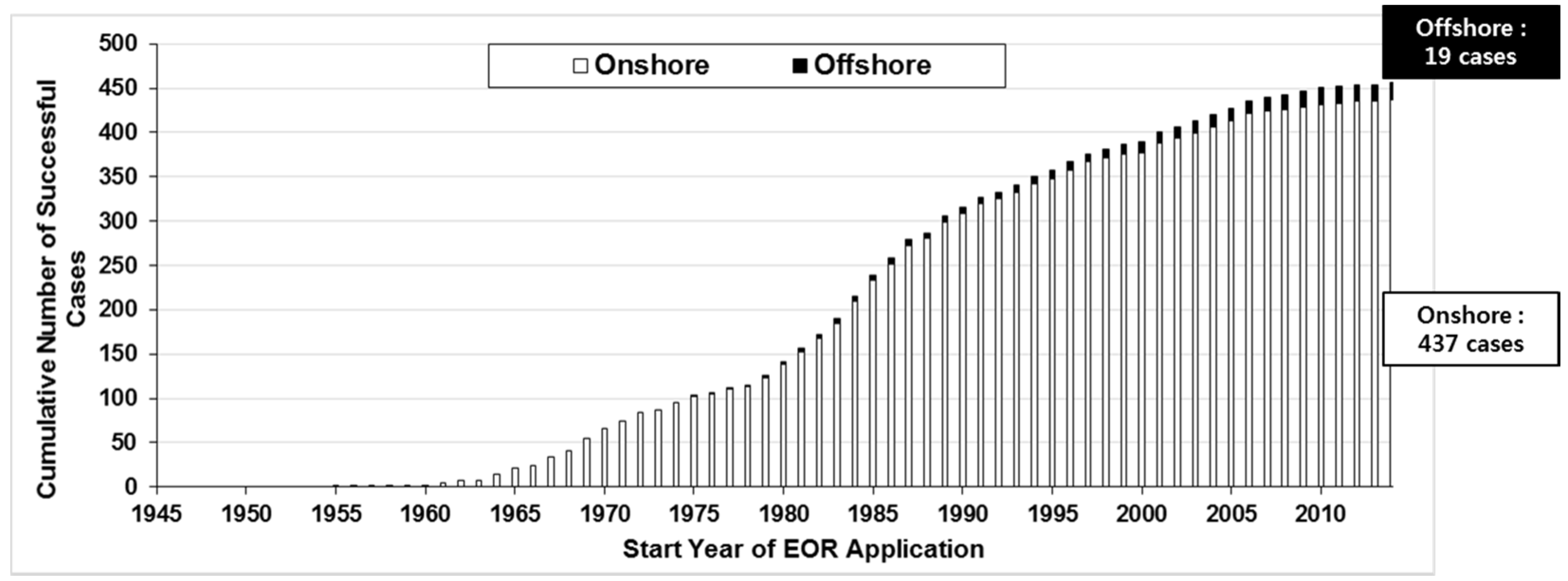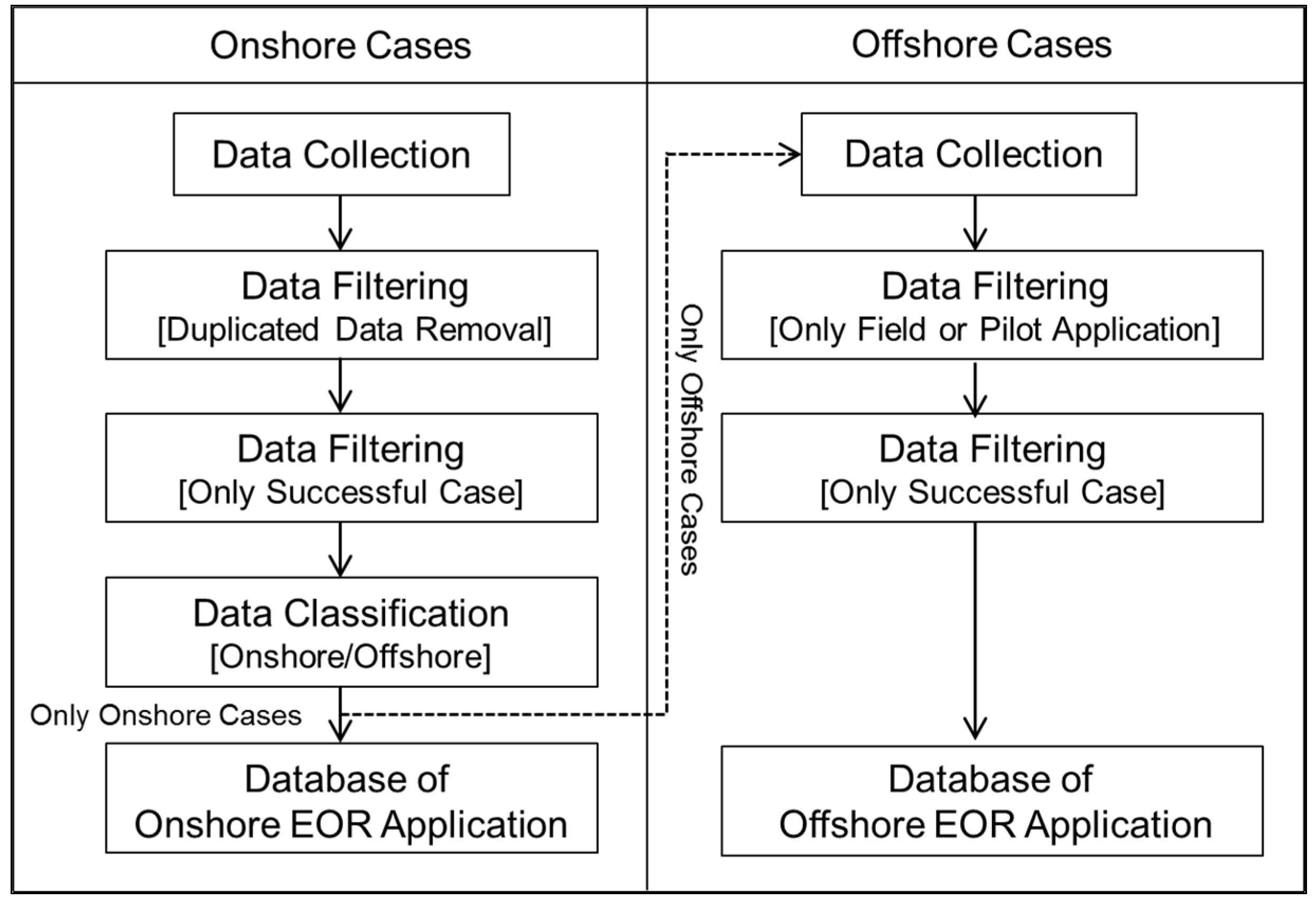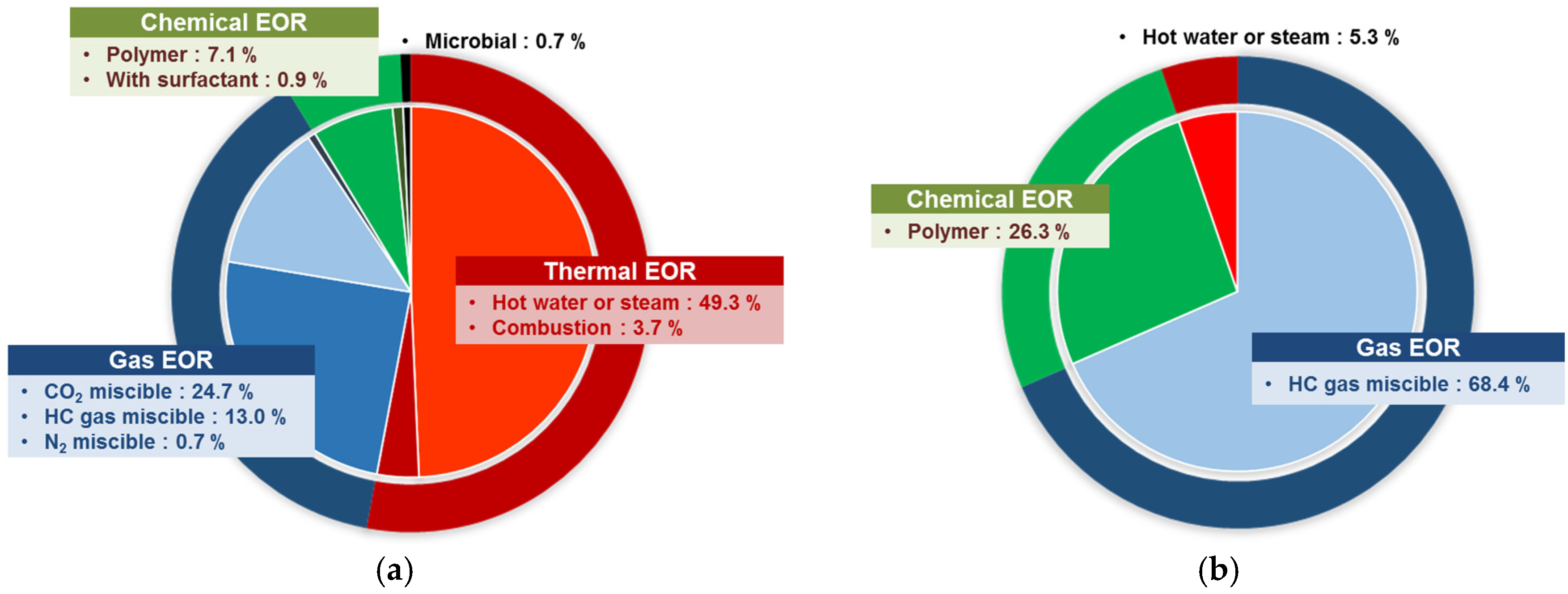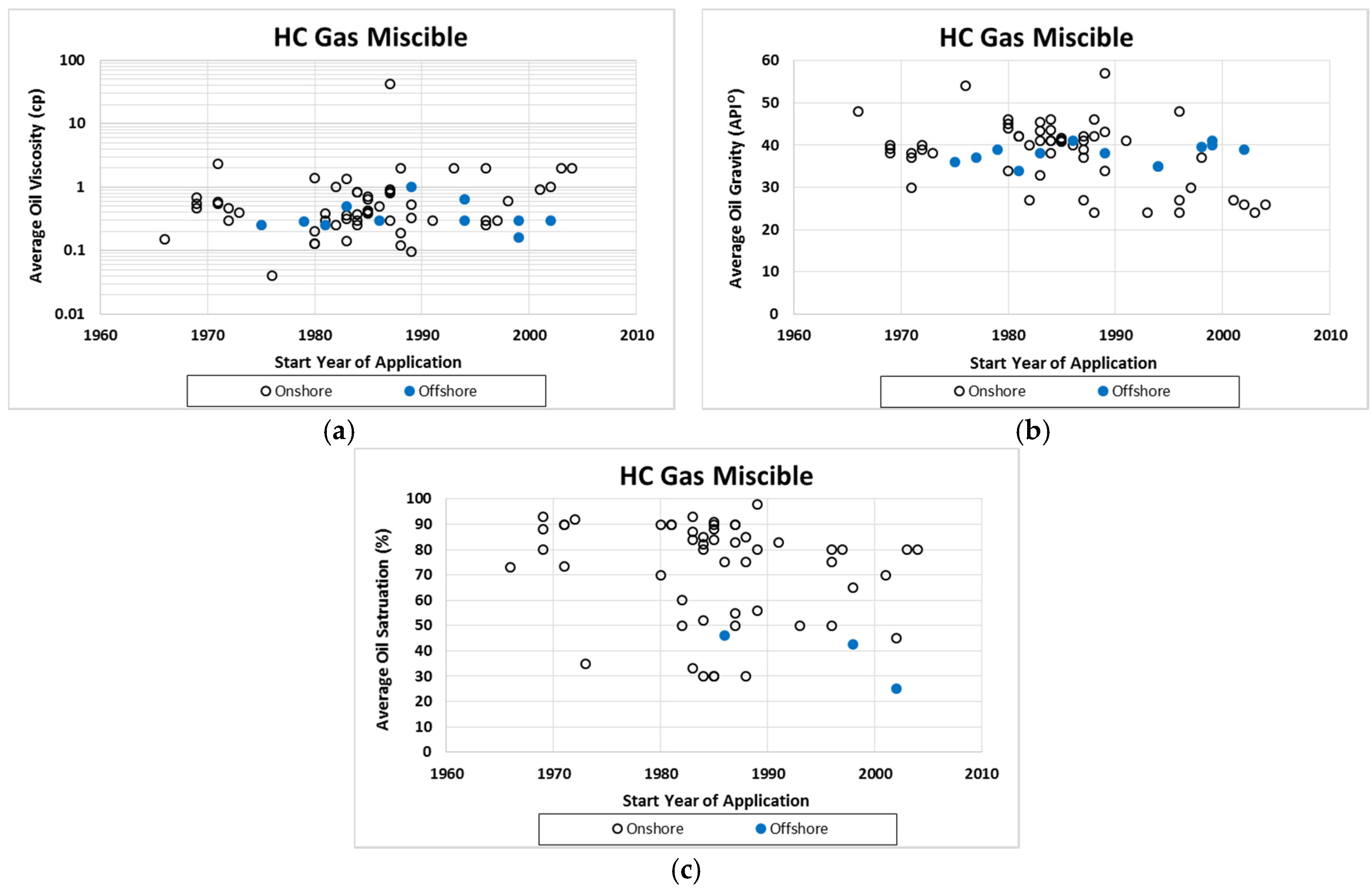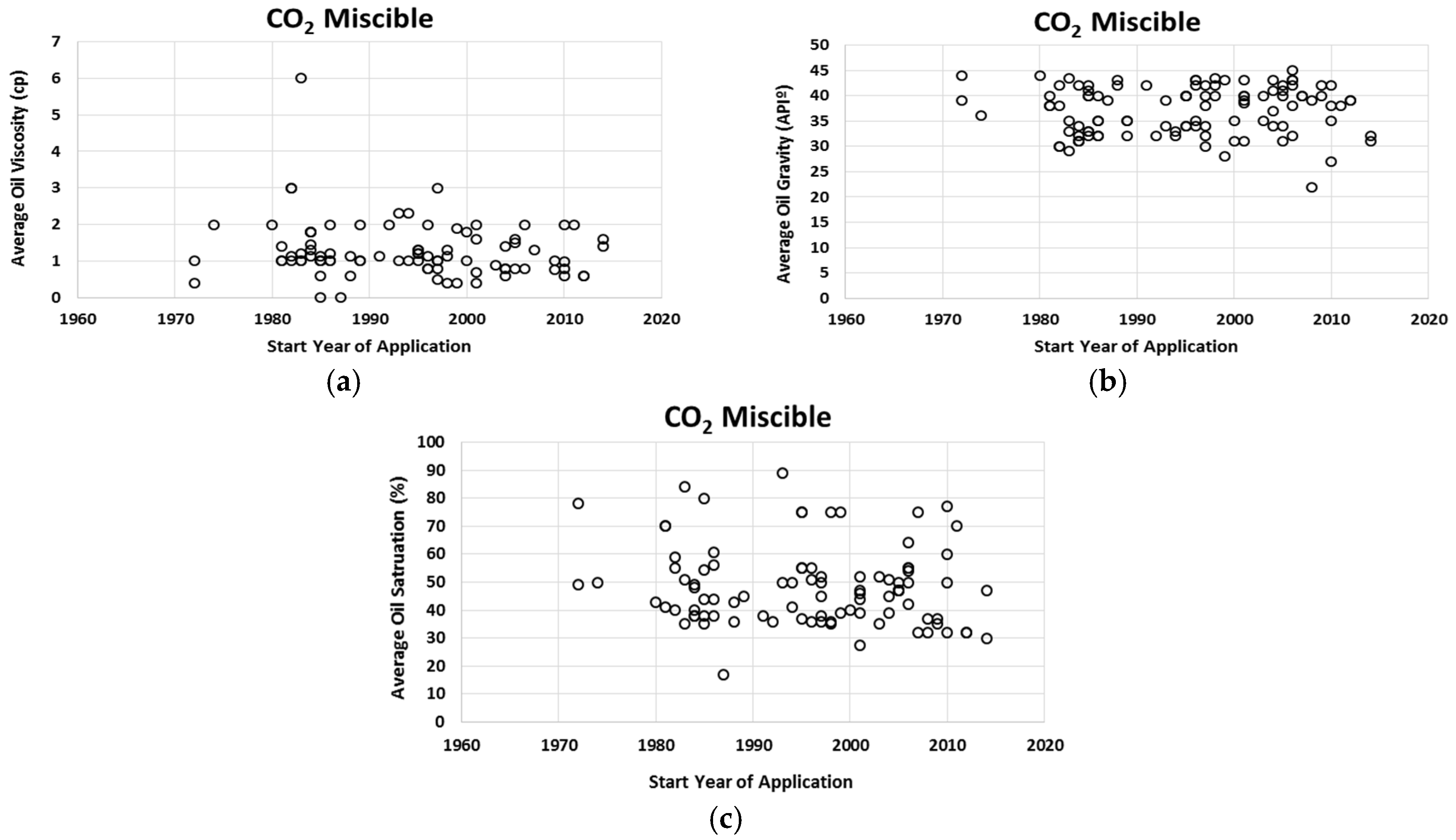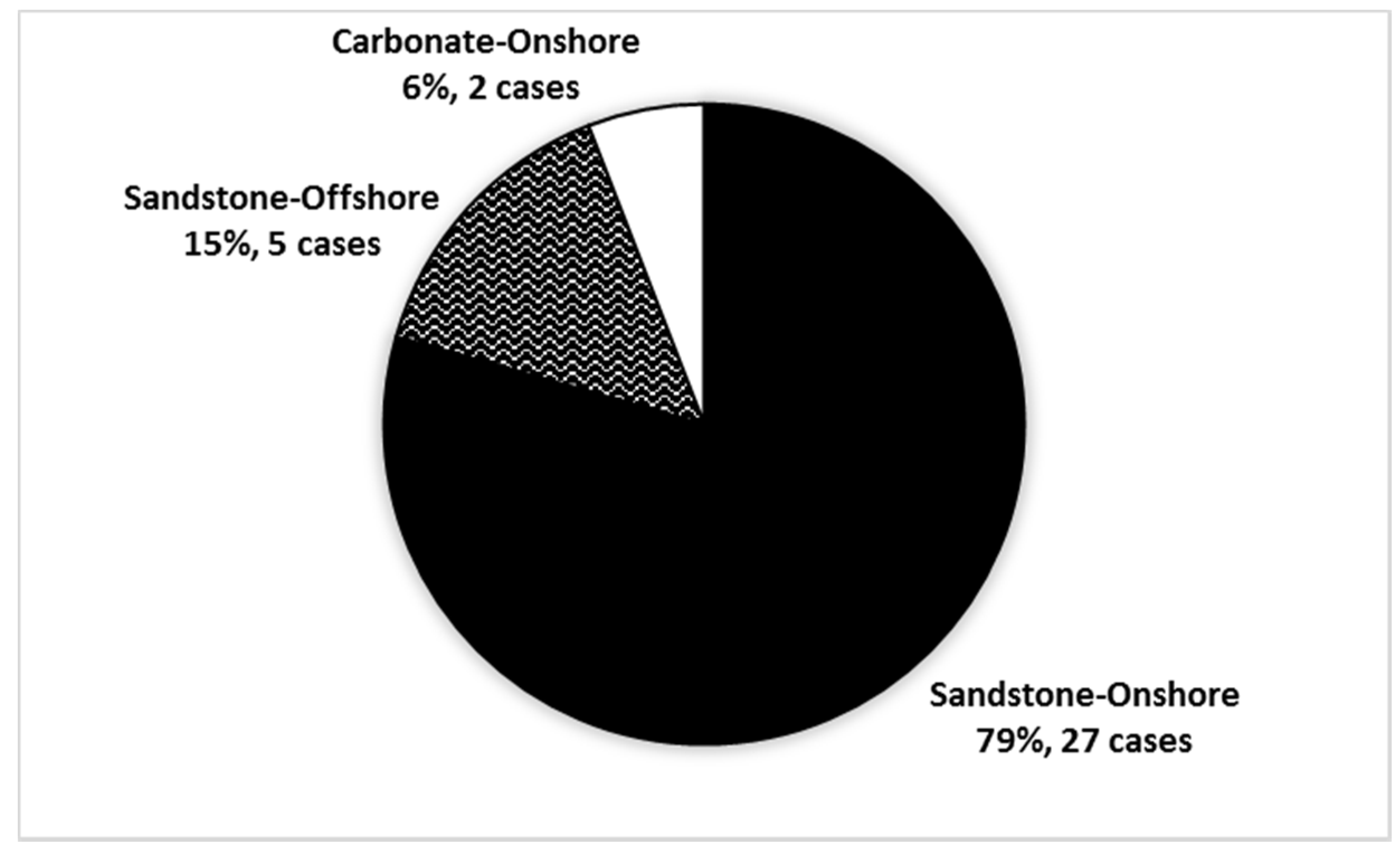The polymer process in offshore fields has predominantly been applied in Bohai Bay, offshore China. Additionally, successful pilots in the Captain Field (North Sea) has been reported. Since the polymer process has been proven by onshore applications, it has high potential for offshore applications.
5.1. Data Analysis
Table 6 shows previously suggested screening criteria for the polymer process. Based on data availability and the relevant polymer EOR characteristics, the formation type, oil viscosity, gravity, reservoir temperature, and permeability were analyzed.
Table 6.
Previously-suggested screening criteria for the polymer process.
Table 6.
Previously-suggested screening criteria for the polymer process.
| Parameters | Reference [21] | Reference [29] | Reference [30] | Reference [31] | Reference [43] |
|---|
| Oil Viscosity (cP) | <200 | <20 | <150 | <150 | <100 |
| Oil Gravity (cP) | - | >25 | >15 | - | >22 |
| Oil Saturation (%) | - | >10 | >50 | >60 | >50 |
| Salinity (ppm) | <100,000 | <100,000 | - | <100,000 | <100,000 |
| Hardness (ppm) | <500 | - | - | <1000 | <5000 |
| Wettability | - | water-wet preferred | - | - | - |
| Depth (ft) | - | <9000 | <9000 | - | <9000 |
| Formation Type | - | sandstone preferred | sandstone preferred | - | sandstone preferred |
| Temperature (°F) | <200 | <200 | <200 | <158 | <200 |
| Permeability (md) | >10 | >20 | >10 | >50 | >50 |
| Porosity (%) | - | ≥20 | - | - | - |
| Net Thickness (ft) | - | >10 | - | - | - |
| Water Drive | - | - | - | no a | no a |
| GOR | - | - | - | <10 | - |
While very small pore sizes cause polymer entrapment, leading to low polymer injectivity, the average porosity that is generally reported cannot reflect the full extent of polymer trapping possibilities. Therefore, porosity was not considered when setting screening criteria. Residual oil saturation data is more important for polymer application than average oil saturation at start point of polymer flooding because general targeted oil of polymer flooding is bypassed oil. However, most field data about residual oil saturation was not available and very different depending on reservoir. Although viscoelastic property of EOR polymer can decrease residual oil saturation, there are different opinions about how viscoelastic property of polymer works for decreasing residual oil saturation. Specific criteria of oil saturation closely relates with economics, screening criteria about oil saturation was changed to “oil saturation > residual oil saturation”. Most polymer cases have been implemented in sandstone (or loosely-consolidated sand) reservoirs, as shown in
Figure 6. The formation type for all offshore cases is sandstone, owing to concerns over the high retention of polymers in carbonate reservoirs.
Figure 7a shows two onshore cases with much higher oil viscosity than other cases; these are the Pelican Lake cases. Maximum oil viscosity in the Pelican Lake field is approximately 40,000 cP [
48]. Such ultra-high oil viscosity may cause injectivity problems. Considering the long injection lines in cold sub-sea conditions and the high costs in offshore fields, these cases were not considered when setting the screening criteria. Except for the Pelican Lake cases, polymer processes in offshore fields were applied under high oil viscosity conditions compared with onshore cases and the previously-suggested screening criteria. Four offshore fields, offshore China, use a newly developed hydrophobically-associating polymer, which has a high salinity tolerance and stability of shear degradation. Considering these cases, screening criteria for the polymer process could be widened as polymer technology develops.
Figure 7b shows a trend in polymer applications toward heavier oil reservoirs in recent years, and offshore applications are also for heavier oil conditions than most early onshore cases.
Figure 7d shows that offshore applications of the polymer process exist in high permeability conditions.
Figure 6.
Formation type of polymer applications in onshore and offshore fields.
Figure 6.
Formation type of polymer applications in onshore and offshore fields.
Figure 7.
Application data for the polymer process by start year of application. (a) Oil viscosity; (b) Oil gravity; (c) Reservoir temperature; (d) Reservoir permeability.
Figure 7.
Application data for the polymer process by start year of application. (a) Oil viscosity; (b) Oil gravity; (c) Reservoir temperature; (d) Reservoir permeability.
Water salinity and hardness can critically affect the feasibility of polymer injection because polymer viscosity drastically decreases with increases in salinity and hardness. Above a critical hardness level, polymers can precipitate causing formation damage. Formation salinity and hardness data are only available for three offshore cases, as shown in
Table 7. The salinity and hardness of these cases in China are low compared with general offshore field. There is one polymer application case in offshore environment which is not included in
Table 1. In Dalia Field (Angola), salinity is up to 93,900 ppm and hardness is 21,300 ppm but production responses have not yet been reported due to long well space.
Table 8 shows the new screening criteria, with the boundary values updated as analyzed in
Figure 7.
Table 7.
Salinity and hardness of offshore fields.
Table 7.
Salinity and hardness of offshore fields.
| Field | Salinity (ppm) | Hardness (ppm) |
|---|
| PF-A | 6540–20,000 | 30–800 |
| PF-B | 2873 | 10 |
| PF-C | 3000–6500 | 13 |
Table 8.
New screening criteria for the polymer process.
Table 8.
New screening criteria for the polymer process.
| Screening Criteria by Oil and Reservoir Properties |
|---|
| Parameters | EOR Screening Criteria |
| Formation type | sandstone preferred |
| Oil viscosity (cP) | ≤240.0 |
| Oil gravity (°API) | ≥15.2 |
| Oil saturation (%) | >residual oil saturation |
| Reservoir temperature (°F) | ≤185.0 |
| Reservoir permeability | ≥10 |
| Salinity of formation water (ppm) | ≤20,000 |
| Hardness of formation water (ppm) | ≤800 |
| Screening Considerations by Offshore Constraints |
| Constraints | Injectant | Disposal | Production | HSE |
| Remote location | compatible water with low salinity and hardness requirement | recycling of produced polymer | on-site fluid separation preferred | biocide |
| preparation of homogeneous polymer solution with minimum impurities | reinjection of produced water with polymer | powdered polymer |
| large storage capacity preferred |
| Expensive well | polymer with long-duration stability required | - | - | - |
| Limited space, weight | individual unit preferred | overboarding poorly biodegradable polymer | emulsion mitigation with consideration of polymer precipitation | individual unit preferred |
| fast hydration of polymer |
| Subsurface system | polymer shear degradation | - | - | - |
5.2. Screening Criteria and Consideration for Polymer Process
Owing to the strong influence on viscosity of partially-hydrolyzed polyacrylamide (PHPA), which is the most widely used EOR polymer, injection water with low salinity and low hardness is needed, as too high a cation concentration may increase the possibility of scale deposition. Cation concentrations in seawater and typical formation water in offshore fields are high. Considering the problems of clay swelling, deflocculation, and scale deposition, water management is very important for polymer flooding applications in offshore fields. Considering the limited space, weight, and heat availability offshore, conventional thermal-based water desalination techniques, such as multi-stage flash distillation, multi-effect distillation, thermocompression distillation, and mechanical vapor compression, are challenging to implement. In contrast, the membrane-based reverse-osmosis method is compact, lightweight, and requires no heat. However, its major disadvantage is that it provides almost fresh water. Too low a cation concentration may increase the possibility of clay swelling and deflocculation. Ayirala
et al. [
49] suggested a new desalination method that can control the cation concentration of injection water. Xanthan and newly-developed polymers, such as 2-acrylamido-2-methylpropane sulfonic acid (AMPS), poly-vinyl pyrrolidones (PVP), or N-vinyl pyrrolidones, have high tolerance to divalent cations. In the case of these polymer application, high salinity and hardness issues can be mitigated.
For oils with a high acid number, which are found frequently in offshore reservoirs, naphthenic acids in the oil can form very stable emulsions. Polymer addition tends to worsen the emulsion problem, which can be a significant problem owing to the severe constraints on offshore facilities. Some of the injected polymer is produced alongside emulsion and increases the emulsion stability and viscosity [
50], leading to a long processing time for emulsion breaking on the platform. To reduce emulsion breaking time, a heating method is usually applied in offshore fields. However, temperatures higher than the cloud point of the polymer causes polymer precipitation. The precipitated polymer can induce heating equipment failures, including heat exchangers and in-vessel heating elements, such as fire tubes. Chemical additions may be needed to elevate the cloud point of produced polymer fluids [
51].
PHPA is not sensitive to biodegradation, which is a good factor for performance in reservoirs. However, environmental restrictions limit the overboarding of poorly biodegradable EOR chemicals. Recycling of produced polymer is one possible option considering the remote location from the shore, but the reconstitution of produced polymer for injection is not yet a proven technology and is currently not cost effective. For injection, a homogeneous polymer solution is required because polymer that aggregates in injection solutions can cause injection problems. Fe
2+ and O
2 in the water can easily degrade PHPA, and often come into contact with the polymer solution during its preparation and transportation. Thus, preparation, transportation, and injection of a homogeneous polymer solution with low impurities (Fe
2+ and O
2) are important. A pressurized inert gas blanket, such as nitrogen, is an effective solution, as is the addition of reducing chemicals; approximately 10% to 30% ITW (isopropyl alcohol and thiourea in water) or biocide is sometimes added to polymer solutions to prevent polymer degradation. Although EOR polymers are known as non-toxic materials, disposal of produced polymer with chemical additives must be avoided. Polymers also hinder water-processing separators that are used for water cleanup, and separated polymer water may contain several hundred ppm of dispersed oil. In most parts of world, residual oil-in-water content in overboard water must be 29 ppm or lower [
51]. Thus, reinjection of produced water should be considered as a possible option.
Commonly, there are two types of polymer: powder and emulsion. Although emulsion polymers are easier to handle, they involve higher costs than powder polymers. Most offshore fields, including SZ36-1, PF-A, PF-B, PF-C, and Dalia used powder polymers. For powder polymers, space and time are required for mixing and hydration of the dry polymer. Considering the limited space on the platform, fast hydration of polymer is important. Specialized polymer mixing and hydration equipment is needed to reduce the time required for injection polymer solution preparation.
In case of xanthan injection, bioxide is always injected (even in PHPA injection, bioxide is sometimes injected) and the bioxide presence on the offshore platform is one of serious HSE issue. Powdered polymer in the air on the platform can also be a HSE issue. Therefore, the bioxide and polymer powder are needed to be handled and separated from people on the platform.
Shear degradation of polymer near the choke is an important issue in offshore fields. According to Rivas and Gathier [
52], between 30% and 70% viscosity loss of the polymer solution can occur depending on the choke dimensions and the polymer concentration and type. In order to compensate for this viscosity loss, polymer over-dosing may be required, but this may increase operation expenses significantly. Long well spacing means a long residence time for the polymer in the reservoir, increasing the time for which the polymer must be stable under reservoir temperature, salinity, and hardness conditions.
Independent units (a barge, FPSO, or jack-up rig) may reduce the cost of implementation for EOR projects considering the added flexibility of space utilization, opportunities for leasing the required equipment, mobility, and relative ease of operation for EOR facilities by specialist EOR companies [
53].
